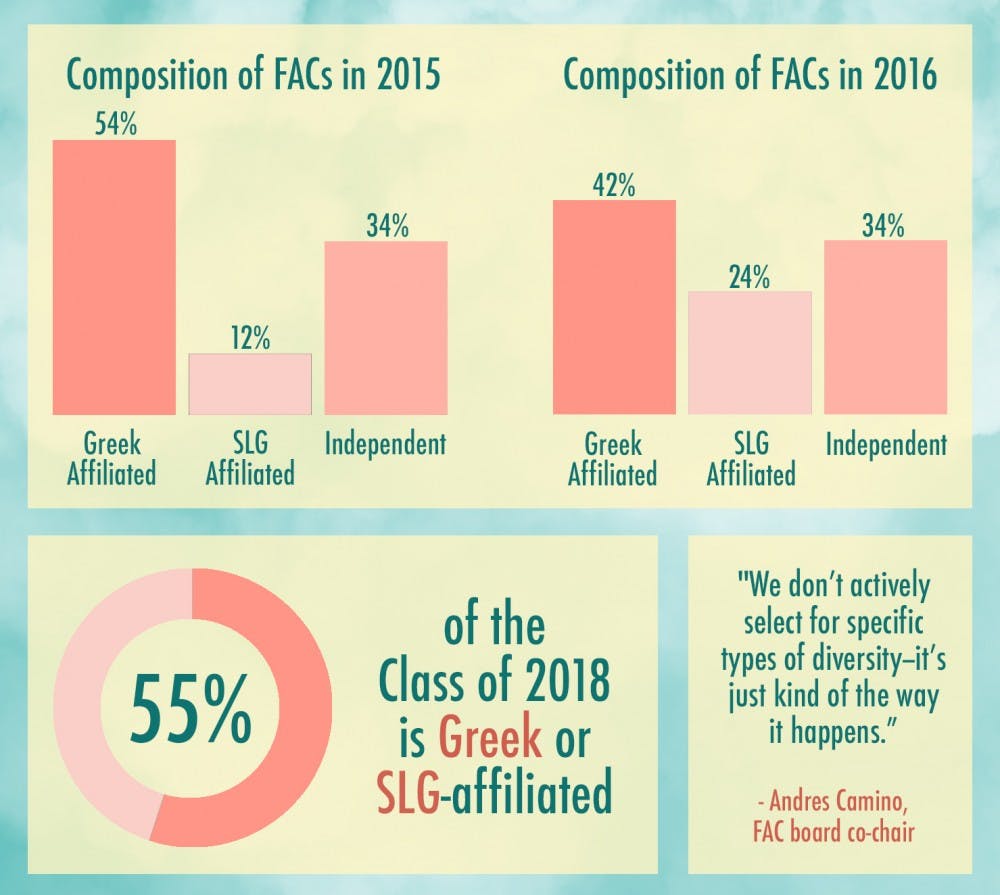The first-year advisory counselor program has seen slight changes in diversity of its participants compared to last year in regards to diversity.
The 230 FACs this year are meant to serve as resources for freshmen and facilitate their transition to Duke, particularly in group discussions during Orientation Week. Criticisms in past years of the FAC program have focused on a lack of diversity among FACs—particularly regarding race, ethnicity and Greek affiliation.
“I would say it’s not really a part of the process itself. We don’t actively select for specific types of diversity—it’s just kind of the way it happens,” said senior Andres Camino, FAC board co-chair. “We’re happy about the process of selecting FACs because we do think it’s able to help us have good representation of the diversity on campus.”
Last year’s FACs were 54 percent Greek-affiliated and 12 percent SLG-affiliated, leaving only 34 percent of the FACs as non-affiliated. This year, statistics provided by co-chairs reflect a decrease in proportion of Greek-affiliated FACs—down to 42 percent—and an increase in proportion of SLG-affiliated ones—doubled to 24 percent. The percentage of non-affiliated, or independent, FACs is still 34 percent.
According to statistics provided to FAC Board co-chairs and seniors Andres Camino and Jay Rathinavelu by Housing, Dining and Residential Life, 55 percent of the Class of 2018 is either Greek or SLG-affiliated, and 45 percent are classified as independent.
According to the Office of Fraternity and Sorority Life website, only 34 percent of Duke students overall are Greek-affiliated.
Thus, the percentage of FACs who are affiliated in some way has not changed over the past two years and still is disproportionately high compared to the Class of 2018. Greek-affiliated FACs have seen a relative decrease in proportion, although they still remain higher than the reported overall average.
Camino wrote in an email that the doubling of SLG-affiliated FACs and the drop in Greek-affiliated was not intentional, and that “the affiliation of a candidate is not under consideration at any point in the application process.”
Kunal Potnis, who was part of the FAC program as a sophomore in 2014 and is again this year as a senior, wrote in an email that changes over the past few years in FAC recruitment and training has led to a recent improvement in how representative FACs are of the general student body.
“I do think the FAC population is diverse. It is not perfect, but it gets better and better every year in my view,” he wrote. “This diversity spans from cultural backgrounds to living preferences to on-campus affiliations to academic interests to numerous other areas. I think this is very important to foster an inclusive environment for first-year students and highlight the wide range of opportunities available at Duke.”
Camino acknowledged that in the past, the FAC program was not representative of the student body.
“So that’s definitely something that has changed I think in recent years—making sure that it is as diverse and representative of Duke as possible," he said. "It’s something that we look at every year, to make sure it’s still going in that trajectory.”
According to the statistics provided by Camino and Rathinavelu, 55 percent of the FACs this year identified as white/Caucasian, 28 percent as Asian/Asian American/Pacific Islander, 6 percent as black/African-American, 8 percent as Hispanic/Latino and 3 percent as multiracial. These numbers are relatively similar to the race and ethnicity breakdown of the Class of 2019, as provided by HDRL. According to the Office of News and Communications, only 46 percent of all Duke students enrolled in Fall 2015 identified as Caucasian, 22 percent as Asian-American, 10 percent as African-American and 7 percent as Hispanic.
Get The Chronicle straight to your inbox
Signup for our weekly newsletter. Cancel at any time.

